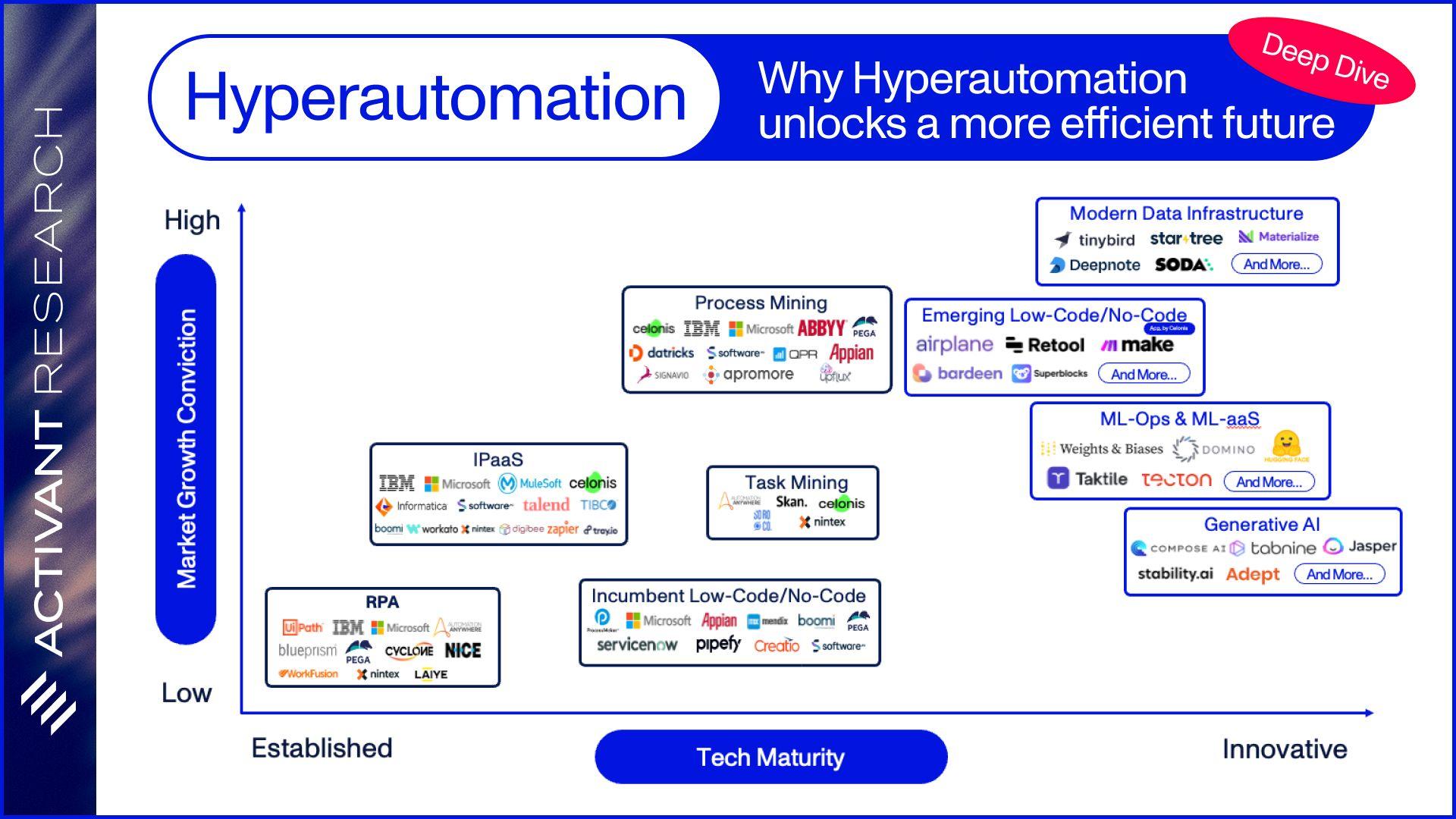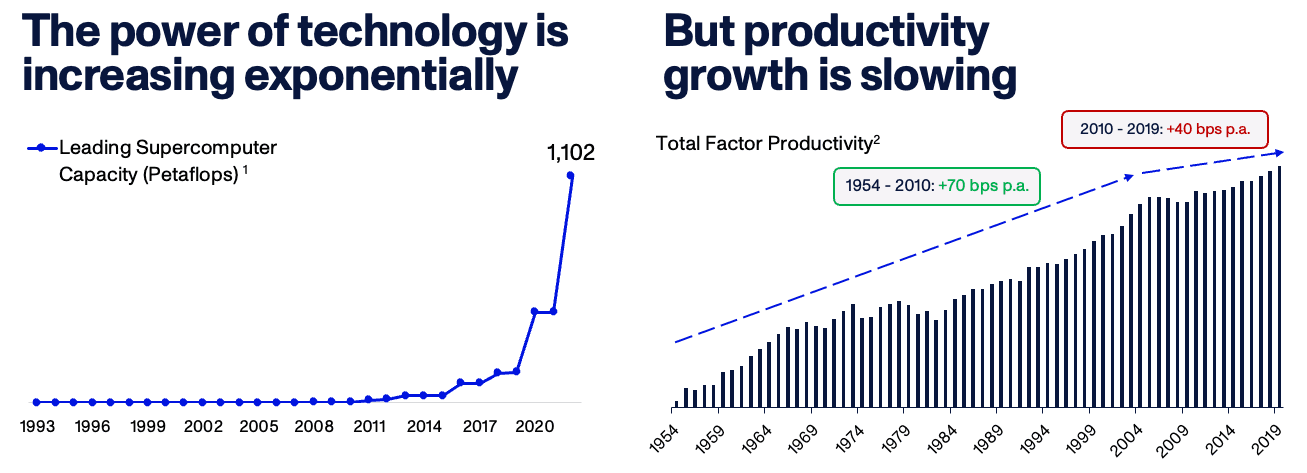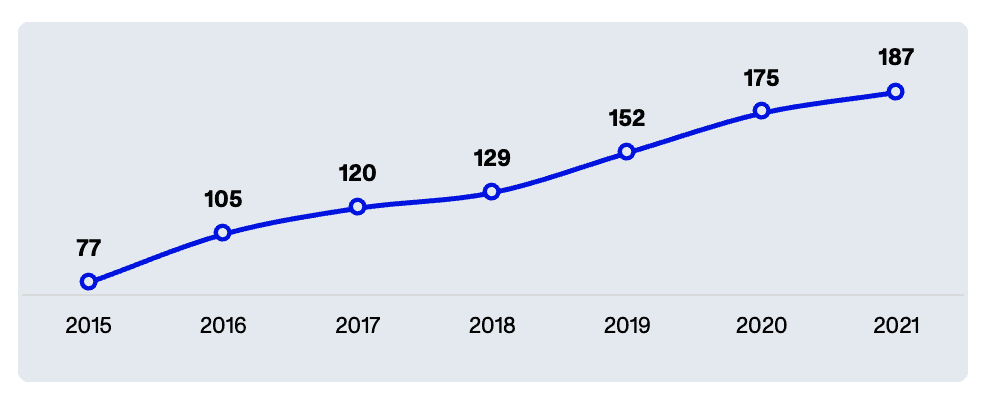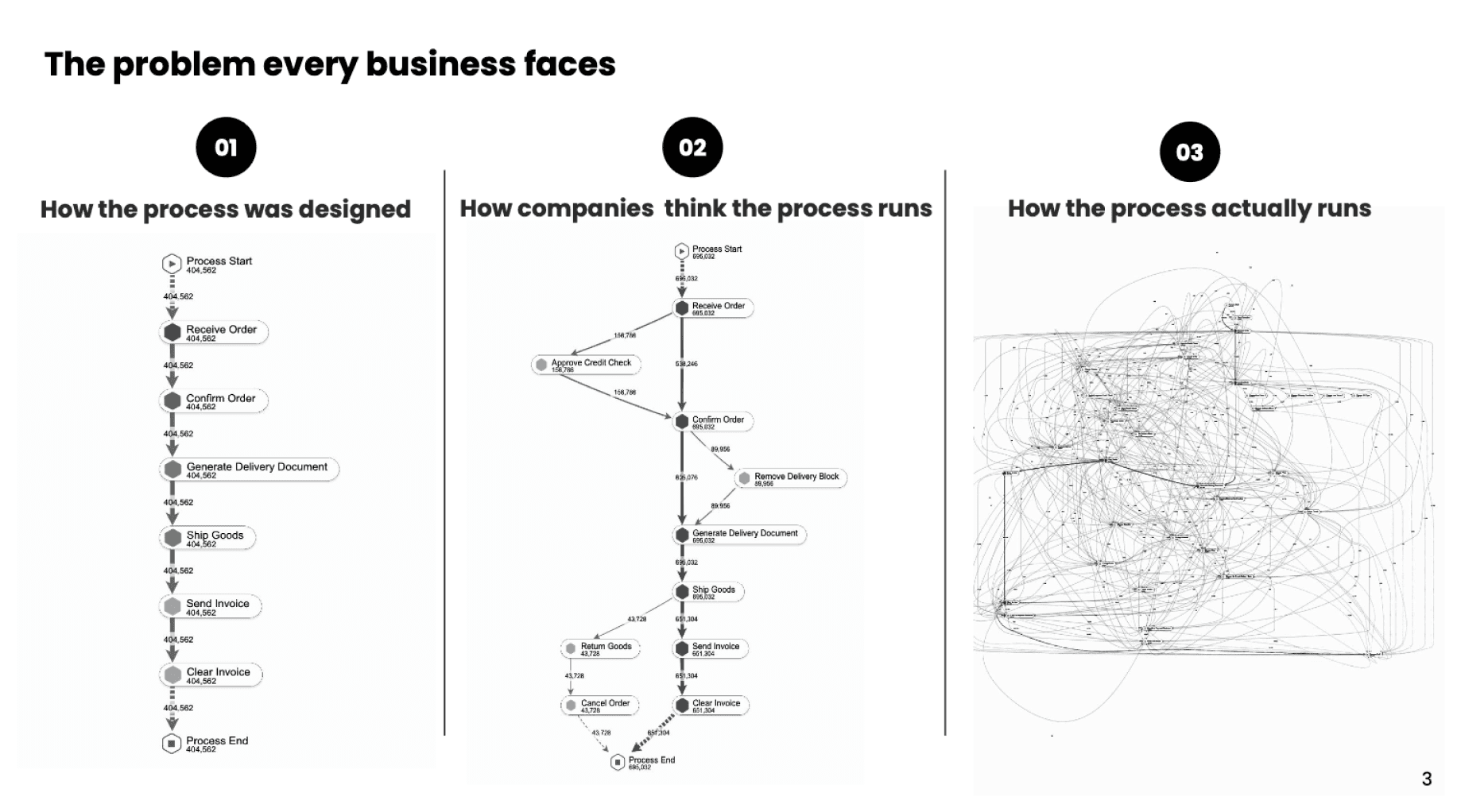Topic
Automation
Published
February 2023
Reading time
6 minutes
Why Hyperautomation Will Unlock a More Efficient Future
Our deep dive report on the race to control corporate chaos
Why Hyperautomation Will Unlock a More Efficient Future
Download ReportResearch

A global airline was struggling with mass flight delays. Antiquated scheduling software or a faulty refueling process? No – it was coffee machines that kept breaking and had to be fixed as part of the pre-flight checklist.
But with a fleet of nearly 300 planes, over 100,000 employees, flying 100 million customers a year, this problem was completely invisible – at least at first. With so much complexity and so many moving parts, the airline couldn’t identify the root cause.
But they found it using software from the fast-growing segment known as process mining. These platforms are like an x-ray for an enterprise business. They create an automated, real-time view of operations, which forms the foundation for analysis and true automation.
In a world where complexity is only increasing, we’re in dire need of technologies to curtail the chaos. We’re excited to launch our deep-dive report on process mining and the broader trend of Hyperautomation – which is shaping up to be a $860bn market.
Download the full report by clicking the button above - and see below for the 5 things you need to know.
1Computers are more powerful than ever, but we're not getting any more productive
Research

Sources:
- Our World in Data, Computational Capacity of the Fastest Supercomputers, 2021; Top500.org, November 2022
- Federal Reserve Bank of St. Louis, Total Factor Productivity at Constant National Prices for United States, November 2022
The power of today's computers is increasing exponentially, and the way we communicate and consume feels cutting edge. Which makes it surprising to learn that society’s productivity growth is slowing.
There is a massive disconnect between the possibilities enabled by technology, and what today’s enterprises are achieving. Digital transformation needs to close this gap.
2More software tools aren’t the answer: the average enterprise uses 187 different applications, which just increase complexity
Research
Average # of Apps Used by Large Companies

Source: Okta, Businesses at Work 2022, Page 5
Each piece of software individually promises to streamline workflows – and most of the time, that’s true.
But it’s humans that are often left to interpret and interpolate information from one software platform to the next, on top of also needing to successfully collaborate with each other. It’s safe to assume, then, that with each new tool added, complexity reduces on a small scale but increases across the organization – to the tune of hundreds of millions of dollars lost to inefficiency.
So, it’s no surprise that 60% of CIOs believe that technical debt is increasing.
3Automation is the solution – but only if you know how and where to point it
Research

Source: Celonis
We’ve seen many approaches to automation, but process mining comes out above the rest. Methods like RPA (Robotic Process Automation) can only automate a process as you understand it – which is just the tip of the iceberg, because what’s happening is always more complex. 97% of organizations have failed to scale their RPA efforts because automating parts of a broken process won’t fix the underlying issues. The automation journey needs to start with first understanding the problem, and then applying the right technology. Enter process mining.
Process mining is the x-ray for your business processes. Using the data from existing systems, like ERP and CRM, process mining shows users the disconnect between the ideal process and the actual process. This analysis tends to reveal a web of inefficiency and drive insights that management could never have dreamed of without such a powerful tool. We sum this up as visibility and continuous monitoring, which forms the basis of targeted and systemic process improvement. Said differently, once you know what's wrong, you can fix it.
4We Invested in Celonis, the leader in global process mining and now execution management
Celonis pioneered process mining and has taken it to the next level with the Execution Management System (EMS). The EMS is a holistic, end-to-end system that uses process mining to integrate data across sources, reveal inefficiencies and take the requisite actions to correct them.
Celonis is transforming enterprises like GE Healthcare, Accenture, Uber and many more. From €66M in real cash savings for T-Mobile to cutting a 6-month project down to 6 weeks for Deutsche Bank or reducing overdue payments by 30% for Kraft Heinz, their technology is universally applicable across enterprises. They have recently launched a new set of products – Process Sphere & Business Miner – further advancing their undisputed market leadership position.
.
The first ‘aha moment’ was when we downloaded data into Celonis from our systems, and we saw the spaghetti diagram of our processes… Despite the fact we’ve been working on standardizing our processes for the last 15 years, it turned out that we still have room for improvement.”

Enikö Csillik, Head Of Service Management, Hydro
5But this market is just getting started - here are four emerging sectors we're watching
- Emerging Low-Code/Now Code: Companies spend >30% of their developer resources building internal software where off-the-shelf software is not fit-for-purpose. These internal tools can drive automation in core business areas, but they tend to fall short of the quality bar. Companies like Airplane, Retool, Make, Bardeen, and Superblocks are building tools that rapidly scale professional software development for technical and non-technical users.
- Modern Data Infrastructure: Today, many are becoming believers that machine learning / artificial intelligence is going to be a key driver of the modern enterprise. But 87% data science projects never make it to production. Companies like Tinybird, Startree, Materialize, Deepnote & Soda are building the tools to break down data siloes and ensure that data is never the bottleneck to data science success, building modern data stacks that are real-time, scalable & observable.
- ML-Ops & ML-aaS: At the same time, companies like Weights & Biases, Domino Data Labs, Hugging Face, Taktile & Tecton are building the infrastructure that machine learning engineers need to build, deploy & scale ML fast.
- Generative AI: It’s all the hype today, and for good reason. While this emerging category brings with it a number of unanswered questions, we see the potential for a natural language interface for every knowledge worker to automate substantive pieces of their daily work and spend their time only where it provides the highest leverage. Companies like Compose AI, Tabnine, Jasper, Stability AI & Adept are building the tools for AI-generated writing, images and code.
We're excited about the next generation of tools that are fighting entropy in the enterprise. If you're building a company in the space or just want to share your thoughts on our report, please get in touch.
Disclaimer: The information contained herein is provided for informational purposes only and should not be construed as investment advice. The opinions, views, forecasts, performance, estimates, etc. expressed herein are subject to change without notice. Certain statements contained herein reflect the subjective views and opinions of Activant. Past performance is not indicative of future results. No representation is made that any investment will or is likely to achieve its objectives. All investments involve risk and may result in loss. This newsletter does not constitute an offer to sell or a solicitation of an offer to buy any security. Activant does not provide tax or legal advice and you are encouraged to seek the advice of a tax or legal professional regarding your individual circumstances.
This content may not under any circumstances be relied upon when making a decision to invest in any fund or investment, including those managed by Activant. Certain information contained in here has been obtained from third-party sources, including from portfolio companies of funds managed by Activant. While taken from sources believed to be reliable, Activant has not independently verified such information and makes no representations about the current or enduring accuracy of the information or its appropriateness for a given situation.
Activant does not solicit or make its services available to the public. The content provided herein may include information regarding past and/or present portfolio companies or investments managed by Activant, its affiliates and/or personnel. References to specific companies are for illustrative purposes only and do not necessarily reflect Activant investments. It should not be assumed that investments made in the future will have similar characteristics. Please see “full list of investments” at https://activantcapital.com/companies/ for a full list of investments. Any portfolio companies discussed herein should not be assumed to have been profitable. Certain information herein constitutes “forward-looking statements.” All forward-looking statements represent only the intent and belief of Activant as of the date such statements were made. None of Activant or any of its affiliates (i) assumes any responsibility for the accuracy and completeness of any forward-looking statements or (ii) undertakes any obligation to disseminate any updates or revisions to any forward-looking statement contained herein to reflect any change in their expectation with regard thereto or any change in events, conditions or circumstances on which any such statement is based. Due to various risks and uncertainties, actual events or results may differ materially from those reflected or contemplated in such forward-looking statements.








